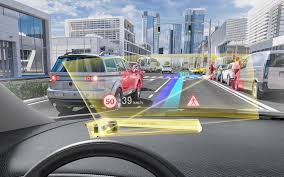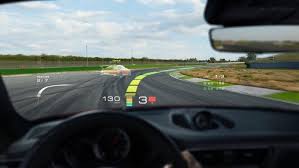Augmented Reality Windshields Revolutionize Driving with Innovative Insights
The automotive industry stands on the brink of a technological renaissance, and augmented reality (AR) windshields are at its forefront. Imagine a world where your windshield transforms into an interactive dashboard, seamlessly blending the physical and digital realms. This isn’t science fiction—it’s happening now. AR windshields enhance safety, navigation, and driver experience by projecting real-time information directly into your line of sight.

The Dawn of AR Windshields: What They Are and Why They Matter
AR windshields integrate augmented reality technology into the glass of a vehicle, overlaying digital data onto the real world. Unlike traditional heads-up displays (HUDs), which are limited to basic speed or navigation cues, AR windshields provide a dynamic, immersive experience. Think of them as a transparent screen that highlights road hazards, displays turn-by-turn directions, or even identifies landmarks—all without taking your eyes off the road.
My fascination with AR windshields began when I first saw a demo at a tech expo. The windshield lit up with glowing arrows guiding the driver through a foggy intersection, while a subtle alert flagged a pedestrian crossing ahead. It felt like stepping into a video game, but the stakes were real. This technology promises to reduce distracted driving, a leading cause of accidents, by keeping critical information in the driver’s field of vision. As someone who’s navigated tricky roads in low visibility, I can’t overstate how transformative AR windshields could be.

How AR Windshields Work: A Technical Marvel
At their core, AR windshields rely on a combination of sensors, cameras, and advanced projection systems. External cameras capture the environment, while software interprets the data—identifying objects like traffic signs or other vehicles. This information is then projected onto the windshield using micro-LEDs or holographic displays, aligned perfectly with the driver’s perspective. Companies like WayRay and Continental are pioneering this space, embedding AR windshields with AI to adapt to real-time conditions.
Reflecting on this, I’m struck by the precision required. During a test drive simulation I experienced, the AR windshield adjusted instantly as I turned a corner, recalibrating the navigation overlay to match the new angle. It’s a symphony of engineering and design, and it’s thrilling to see how AR windshields bridge the gap between human intuition and machine intelligence.
Core Components of AR Windshields
| Component | Function | Impact on Driving |
|---|---|---|
| Cameras | Capture road conditions | Enhances hazard detection |
| Sensors | Monitor speed and proximity | Improves real-time alerts |
| Projection System | Displays data on windshield | Reduces distraction |
This table simplifies the magic behind AR windshields, but it’s their seamless integration that truly impresses me. The potential to save lives by anticipating dangers is what fuels my enthusiasm for this technology.
Safety First: AR Windshields as a Game-Changer
Safety is where AR windshields shine brightest. According to the National Highway Traffic Safety Administration, distracted driving claimed over 3,000 lives in the U.S. in 2022 alone. AR windshields tackle this head-on by eliminating the need to glance at a phone or dashboard. For instance, if a deer darts across the road, the windshield can highlight it in red, giving you precious seconds to react.
I’ve driven through rural areas where wildlife crossings are common, and the anxiety of sudden obstacles is real. With AR windshields, that fear could fade. During a recent conversation with an automotive engineer, they shared how AR windshields could integrate with vehicle-to-vehicle (V2V) communication, warning you of a car braking ahead before you even see it. This proactive approach to safety feels revolutionary, and it’s hard not to get excited about a future where AR windshields make crashes rarer.
Navigation Redefined: A Personal Journey with AR
Navigation is another realm where AR windshields excel. Traditional GPS systems can be clunky—voice prompts lag, and screens divert attention. AR windshields, however, paint directions directly onto the road. Picture a glowing blue line tracing your route, curving with the pavement, or a virtual signpost hovering over your next turn.
I once got lost in a maze of city streets, fumbling with my phone while traffic honked behind me. If I’d had an AR windshield, that frustration would’ve vanished. Companies like TomTom are already partnering with automakers to embed AR windshields with 3D mapping, offering a level of clarity that feels almost futuristic. My takeaway? AR windshields don’t just guide—they empower you to drive with confidence, turning every trip into a smooth adventure.
Beyond the Basics: Unexpected Benefits of AR Windshields
While safety and navigation dominate the conversation, AR windshields offer surprises too. Imagine driving past a historic site, and your windshield flashes a brief description—or spotting a gas station with prices displayed in real time. These small touches elevate the driving experience, blending utility with delight.
Reflecting on this, I recall a long road trip where I wished for more context about the places I passed. AR windshields could turn mundane drives into educational journeys, especially for curious minds like mine. Automakers are exploring entertainment options too, like subtle games for passengers, though I hope they keep the focus on the driver’s needs. The versatility of AR windshields is what keeps me hooked—they’re not just tools; they’re companions.
Challenges and Reflections: The Road Ahead for AR Windshields
No innovation is without hurdles, and AR windshields face plenty. Cost is a big one—retrofitting existing cars or integrating them into new models isn’t cheap. Current estimates suggest AR windshields add thousands to a vehicle’s price tag, limiting them to luxury markets for now. There’s also the learning curve. During my demo, I fumbled with the settings, overwhelmed by the flood of data.
Yet, these challenges feel like growing pains. Mass production could drive costs down, and user-friendly interfaces will evolve. I’m reminded of smartphones—once clunky and expensive, now indispensable. AR windshields could follow that arc, and I’m optimistic they’ll become standard in a decade. Their potential outweighs the obstacles, and that’s what fuels my belief in their future.

Pros and Cons of AR Windshields
| Aspect | Pros | Cons |
|---|---|---|
| Safety | Reduces distractions | Over-reliance risk |
| Cost | Enhances premium vehicles | High initial expense |
| Usability | Intuitive navigation | Steep learning curve |
This table captures my mixed feelings—excitement tempered by pragmatism. AR windshields are a leap forward, but they’re not flawless yet.
The Human Element: How AR Windshields Feel in Practice
What’s it like to actually use AR windshields? In my limited hands-on time, I found them intuitive yet surreal. The display was crisp, even in sunlight, and the alerts were unobtrusive—more like gentle nudges than loud interruptions. Still, I wondered: could they become too immersive? There’s a fine line between helpful and overwhelming, and AR windshields must walk it carefully.
I spoke with a test driver who’d used AR windshields for weeks. They described feeling more in tune with the road, almost like the car was an extension of their senses. That resonates with me—technology should amplify, not replace, human instinct. AR windshields seem to strike that balance, though I’d love to log more miles myself to be sure.
Environmental Impact: A Subtle but Significant Angle
One overlooked aspect of AR windshields is their potential environmental upside. By optimizing routes and reducing idling (thanks to smarter navigation), they could cut fuel consumption. A study from the European Commission suggests AR-enhanced driving systems might reduce CO2 emissions by up to 5% per vehicle.
As someone who cares about sustainability, this perks me up. Pair AR windshields with electric vehicles, and the impact grows. It’s not their primary selling point, but it’s a bonus that aligns with my values. Small wins like these make AR windshields feel less like a gadget and more like a step toward a better world.
Industry Insights: Who’s Leading the AR Windshield Race?
The race to perfect AR windshields is heating up. Tesla’s hinted at integrating them into future models, while BMW and Mercedes-Benz are testing prototypes. Startups like WayRay, with its holographic tech, are pushing boundaries too. Each player brings a unique flavor—Tesla’s minimalism, BMW’s luxury, WayRay’s boldness.
I’ve followed WayRay closely, impressed by their focus on scalable solutions. Their “True AR” system, which uses lasers to create vivid images, feels like a glimpse of tomorrow. Meanwhile, established giants ensure AR windshields aren’t just a niche experiment. This competition excites me—it’s a sign the technology is maturing fast.
A Vision for Tomorrow: Where AR Windshields Could Take Us
Looking ahead, AR windshields might do more than assist—they could redefine driving entirely. Imagine autonomous cars where the windshield becomes a control hub, displaying system status or entertainment during hands-free travel. Or consider fleet vehicles, where AR windshields optimize delivery routes in real time.
I dream of a day when AR windshields connect us more deeply to our surroundings—highlighting local events or warning of weather shifts. It’s a lofty vision, but the seeds are planted. My hope is that AR windshields evolve to enhance not just safety, but our relationship with the journey itself.
Future Applications of AR Windshields
| Application | Description | Potential Benefit |
|---|---|---|
| Autonomous Driving | System monitoring display | Seamless transition |
| Fleet Management | Real-time route optimization | Efficiency boost |
| Tourism | Interactive travel info | Enriched experiences |
This table sparks my imagination—AR windshields could touch every corner of mobility.
Why AR Windshields Captivate Me
AR windshields aren’t just a tech trend—they’re a paradigm shift. They blend safety, convenience, and wonder into a single pane of glass, transforming how we interact with our vehicles and the world beyond. From cutting-edge safety features to navigation that feels like magic, AR windshields have won me over. Sure, they’re not perfect yet—cost and complexity linger—but their trajectory is clear.
Writing this has deepened my appreciation for AR windshields. They’re not just about driving smarter; they’re about driving better, in every sense. As they roll out to more cars, I’ll be watching—and hopefully driving—with wide-eyed anticipation. The road ahead looks brighter, thanks to AR windshields.
